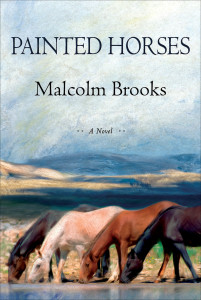 Progress vs. Preservation, Montana in the 1950s: You don’t have to love and know horses or appreciate their role in the history of America’s West to love this historical fiction debut. But I bet Malcolm Brooks does. For I don’t think it’s possible to craft prose so authentic otherwise. The story – with its well-drawn characters and pitch-perfect dialogue illuminated in backstories that transport the reader to other settings and times – Roman London archaeology, Maryland horse country, and the US. Army horse cavalry in WWII – carries an intriguing, important, and timely message. Together, the outcome is a novel worth raving about. An awesome voice.
Progress vs. Preservation, Montana in the 1950s: You don’t have to love and know horses or appreciate their role in the history of America’s West to love this historical fiction debut. But I bet Malcolm Brooks does. For I don’t think it’s possible to craft prose so authentic otherwise. The story – with its well-drawn characters and pitch-perfect dialogue illuminated in backstories that transport the reader to other settings and times – Roman London archaeology, Maryland horse country, and the US. Army horse cavalry in WWII – carries an intriguing, important, and timely message. Together, the outcome is a novel worth raving about. An awesome voice.
Two women from very different backgrounds and two cowboys the reader senses have pasts that badly crossed drive the foreboding story. The two women: Catherine Lemay, an ambitious 23-year old pianist turned archaeologist “in love with the vanished past” and Miriam, a Crow Indian teenager she convinces to be her guide. The two men: Jack Allen, a cocky, enigmatic, chilling-to-watch horse wrangler and John H, the opposite, a horse tamer and talented sketcher of horses, a younger man who has also lived in a saddle.
The story sounds straightforward but it is elusive and complicated, actually. It centers around Catherine being hired for a summer by the Smithsonian to conduct a River Basin Survey prior to the building of a major hydroelectric dam to calm nerves that there’s no historical significance in a canyon south of Billings, Montana, the site of the project. Nothing is calm here, actually.
A private company, Harris Power and Light, and the Army Corps of Engineers are also involved in the project – the power company far more powerful than innocent yet daring Catherine suspects. Early on, there are hints of danger. Catherine may have cut her teeth on ancient Roman (and Greek) archaeology but she knows nothing about New World archaeology in America – not about horses or their cowpunchers, nor the beauty and badlands of Montana, nor the Crow tribe of the great northern plains, nor the Basque sheepherders who immigrated to Montana from Spain and their centuries-old language, Euskara. Most of us don’t either – but we will because Brooks wants us to. All unfold and are skillfully woven together to illustrate deeply felt struggles between the Old World and the New – between older Native Americans who believe the construction site is “sacred” versus modern Crow who need jobs and money, and a power company that means business.
Catherine’s parents and her recent fiancé, David, have general concerns for her safety. Those who better understand what she’s getting herself into include Miriam, who fears getting caught in the middle of her people’s fight; Max Caldwell, an avuncular gas station attendant who seems like a minor character but becomes increasingly important; and John H, whom the reader expects Catherine is destined to know.
John H (the H likely stands for Horses) is the most memorable character of them all. A horse whisperer who “even as a boy can walk into a pasture and catch a horse, even if no one else can catch a horse.” Six years prior, he rescued a dun mare as “though the mare were born to nothing else, as though neither could conceive of another way to exist.” His marvelous voice teaches Catherine and us about horses and a “tract of land that belongs to God Almighty, a testament to the everlasting limits of man.”
The reader is in for quite a ride as the mystery takes off. What, if anything, do Catherine (and Miriam) uncover? It’s a ride taken into remote backcountry mostly on horseback. The language of horses and geology gave my new dictionary a workout! Expect to read about percherons and pommels and quirts and cutting-horses and piebalds and bucksins and Barbs; and of batholiths and gumbos and coulees and cirques and talus slopes and cap rocks.
Far more than the new vocabulary was a feeling of wonder at the author’s writing style. Brooks’ reverence for nature and his unique descriptions of the environment are fantastic – expressions like “lip of the sky” and the “cluck and rattle of throats and wings” and the “quaking aspens and the “air whisper in the grass” and a canyon that “yawns like the mouth of the world.” The novel is loaded with enchanted prose.
Beyond the emotional/controversial cultural preservation versus economic/technological issue of whether this particular Montana canyon is indeed sacred to Native Americans and, therefore, should be preserved, the author wants us to reflect on even bigger, hot-button environmental/existential questions. Max Caldwell answers by saying that it is “greatness [that] gets built on destruction.” When he wonders “what kind of sense any of it makes. Who’s got it right and who’s got it wrong?” you will find yourself wondering the same.
I hope you take this moving ride! Lorraine
Pingback: The One With the Electrodes | Jackie Cangro